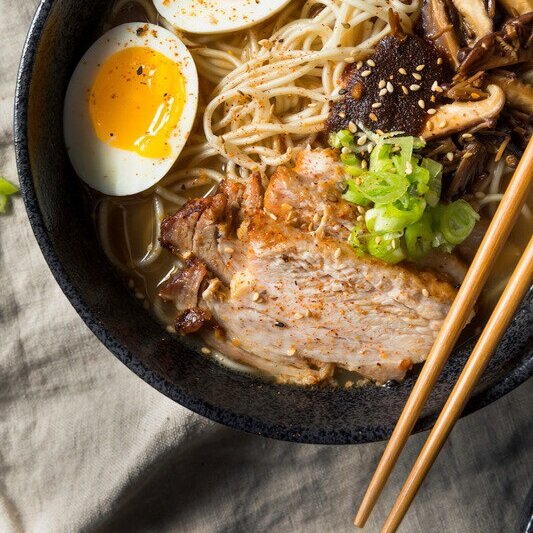Is Tonkotsu Ramen Healthy? (3 Tips for Weight Loss)
Out of all the delicious ramen flavors out there, Tonkotsu Ramen has always remained one of the most popular and loved types of ramen.
Originating in Japan, Tonkotsu Ramen gets its delicious aroma from boiled pork bones that are then made into a creamy broth.
Commonly topped with pork belly, an egg, seaweed, and green onion, this visually aesthetically fish.
In regards to this meal that is good for any occasion, you are probably wondering:
Is Tonkotsu Ramen healthy?
Tonkotsu Ramen is not the ideal food to eat when you are trying to lose weight because it is a relatively high caloric dish that is high in carbs from the noodles, and high in fat from the creamy broth. Although this ramen is not considered a healthy food, that does not mean you can enjoy this meal while on a diet!
In this article, we will discuss in detail the nutritional information behind Tonkotsu Ramen as well as how you can fit this meal into your diet!
Here are 3 tips you can take away from this article:
Make Sure to Focus on Portion Size
Eat Lower Calories Meal Throughout the Day
Understanding How Many Calories You Need to Eat
Tip 1: Portion Size
The most important thing for you to be aware of if you are seriously craving Tonkotsu Ramen is to make sure you are not overeating on this dish.
This is something that can happen very easily because Tonkotsu Ramen is a high calorie and low nutrient dish.
To put the facts behind this claim, let us take a look in detail at the nutritional information for one Tonkotsu Ramen dish.
One bowl of the typical Tonkotsu Ramen has around 44 grams of fat, 91 grams of carbohydrates, and 41 grams of protein.
With around 1000 calories in just one serving of Tonkotsu Ramen, this can seem like a very difficult food to fit into your diet!
I would definitely be on your side if you are thinking that this bowl of ramen is not a great dish to be eating if you are trying to lose weight.
However, as an advocate for flexible dieting, restricting certain foods from your diet has shown time and time again to lead to several diets fails and eventually gaining all the weight back or even more than before!
Why do restricting foods usually lead to such discouraging results?
If you are having a craving and not satisfying it, you are relying on your willpower to prevent yourself from eating food.
As this craving continues to fester while you try to hold yourself back from eating something, eventually you will give in to your cravings and potentially binge on all the foods you restricted yourself from eating.
This is why it is important to listen to your cravings and understand what your body and mind are asking for.
This does not mean that you should just eat whatever you want whenever you want! Remember, if your main goal is to lose weight, eating to your heart’s content is not going to give you the results you are looking for.
Satisfy your craving, but in moderation.
Let’s use this concept when looking at Tonkotsu Ramen. This is a highly calorically dense dish that may be difficult to fit into a diet since it has probably more than half the amount of calories you should be consuming on a daily basis when on a diet.
However, if you are desperately craving Tonkotsu Ramen, try cutting the portion size in half.
Now you have a 500 calorie dish that has 22 grams of fat, 45 grams of carbohydrates, and 20 grams of protein.
This is not too bad compared to before! It is still relatively higher in fat and carbohydrates and lower in protein, but it seems much more reasonable to fit a 500 calorie meal into your day compared to the previous 1000 calories.
If you are going out to eat with friends or family, and sharing is a common tradition, this is the perfect opportunity for you to satisfy your craving while still staying within your diet.
Try ordering a higher protein dish, like a grilled fish, or a voluminous low-calorie salad!
The Tonkotsu Ramen can be up for grabs and feel free to grab a small bowl as a treat.
Now you have only eaten approximately ¼ of the bowl which is only 250 calories!
Let’s review these three scenarios and simplify these choices:
Scenario 1: You eat the whole bowl of Tonkotsu Ramen
Now you only have a few calories left in the day and you get extremely hungry at night or throughout the day, so you possibly end up overeating and entering a calorie surplus.
Scenario 2: You eat half a bowl of Tonkotsu Ramen
Half a bowl of Tonkotsu Ramen may not be enough to satisfy you in one sitting so you possibly end up eating other things on the table and end up eating the same amount of calories as if you ate the whole bowl.
Scenario 3: You eat Tonkotsu Ramen as a side dish
By eating another lower-calorie voluminous dish as your main course and eating Tonkotsu Ramen on the side, you can satisfy your craving and still be satiated after a meal.
Each of these scenarios technically all works and can fit into your diet, but it is up to you to choose what works best for you.
The majority of the people would fall under Scenario 3, but if you feel like you will be full just by eating half the bowl or you only need to eat one big meal for the entire day, then Scenario 1 and 2 work just fine.
This is the beauty of flexible dieting, which teaches you not to classify foods as “good” or “bad” but simply foods that are higher in calories and those that are lower in calories.
When losing weight, the only thing you can do to achieve this goal successfully is to be placing yourself in a calorie deficit.
Tip 2: Eat Lower Calories Meal Throughout the Day
If you know that you are going out to eat for one of your meals for the day, planning ahead of time is key to successfully losing weight.
Now that you know that Tonkotsu Ramen is a very high-calorie dish, you should adjust your other meals throughout the day accordingly.
A good example of planning ahead is to eat a lighter breakfast that gives you just enough energy for the day but not too heavy and fulfilling.
Sometimes not eating breakfast at all might be a
If you are going out for dinner, have a lighter lunch, like a large salad and some chicken breast.
This gives you more wiggle room to eat out at night and still remain within a calorie deficit.
I like to compare this to our spendings account. Imagine that you have $100 to spend for the day and you can spend it on whatever you want.
You have an expensive game that is $60 which you really want to buy, so you reserve your &60 and spend your $40 on cheaper items.
The Tonkotsu Ramen is the game that you really want to buy and the other cheaper items are the smaller meals that you have throughout the day.
It is important to remain within the $100 or you will go into debt or in this particular situation, a calorie surplus.
3. Understanding How Many Calories You Need to Eat
When it comes to understanding calories, it is extremely important to have an idea of what your TDEE (Total Daily Energy Expenditure) is.
This is essentially the amount of calories you burn everyday from your daily activity and movement, your resting metabolic rate, and the amount of calories you burn from digesting your food.
To lose weight, all you need to do is eat less than the total amount of calories you are burning every day!
But you may be wondering how you can figure out what your TDEE is. It’s actually super simple.
Simply find an online calculator that takes your weight, height, and gender and they will automatically calculate a rough estimate of what your TDEE is.
However, keep in mind that everyone’s TDEE varies so it is up to you to make the adjustments after using the estimate.
If you find yourself not losing weight after eating around 300-500 calories (healthy recommendation range) below your TDEE for approximately a week or two, gradually lower your caloric intake 100 calories at a time.
You also do not want to cut too many calories too fast because this will just lead to short term results and cause irresistible hunger cravings for most individuals.
Now that you know the nutritional information for Tonkotsu Ramen, how to incorporate this food into your diet, and understanding the importance of calories and portion control, you are set on the right path to success.
Being educated on the fundamentals of weight loss is key to reaching your goals and we are here to eliminate any misconceptions on losing fat.
CONCLUSION
Remember, although nutrition is a huge factor that influences weight loss, it is important to pair this journey with exercise as well.
Especially strength training.
Several years of research on the benefits of weight training have shown that individuals that do some sort of consistent resistance training at least 3-5 times a week have shown not only a great amount of weight loss but are also able to keep the weight off!
The secret to this phenomena is that strength training leads to a build-up of muscle.
Not only does your body recomposition into a more fitting and athletic-looking aesthetic, but having more muscle also increases your resting metabolic rate which essentially means you burn more calories at rest!
Now that we know the importance of muscle we need to make sure we stay on track with our workouts.
Consistency and longevity are the two key factors when building muscle so there will be some commitment involved.
We understand that not everyone has access to a gym membership or feels comfortable starting off in such an intimidating environment.
Although I would strongly recommend that everyone should get a gym membership, don’t worry we got your back!
You can either go to the gym or build one for yourself.
It really just comes down to 3 pieces of equipment that you need to do most workouts.
These three are the workout bench, dumbbells, and gym flooring.
Check out our recommended gear page to see our best picks for these pieces of equipment here.
https://www.aspirefitnesswalnut.com/home-workout-equipment
If a home gym is not for you then getting a membership somewhere works too.
As long as you are starting your muscle-building journey, we’re happy!
Stick with it for the long run and you’ll see how amazing the results can be.
RECENT POSTS
The Asian Weight Loss Cookbook
The 15 Fat Burning Meals Cookbook features our favorite recipes that you can use to get closer to your fitness goals.
Become your own personal trainer with the guidance of this book and make this the year you achieve your insurmountable fitness goals.
PHILLIP PAK
Phillip Pak is a fitness expert who has been training clients for 6 years. Throughout his fitness journey, Phill has done it all when it comes to diet and nutrition. He is now the owner of Aspire Fitness Walnut where his main goal is to help those who are seeking to find the best version of themselves. Phillip is also a NASM Certified Nutrition Coach (CNC) and a NASM Certified Personal Trainer (CPT).













